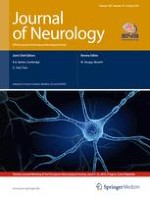Published in:

01-10-2011 | Original Communication
Evaluation of the smooth pursuit tests in multiple sclerosis patients
Authors:
Magdalena Jozefowicz-Korczynska, Anna Maria Pajor
Published in:
Journal of Neurology
|
Issue 10/2011
Login to get access
Abstract
In multiple sclerosis (MS), randomly located demyelination lesions may involve a large part of the central nervous system and disturb oculomotor activity, including impairment of saccadic and pursuit systems. The aim of the work was to determine the frequency of smooth pursuit disturbances in MS patients and assess the feasibility of various methods for smooth pursuit assessment: the clinical bedside examination and quantitative electrooculographic (EOG) recordings. In addition, we analyzed the effects of age on the results of smooth pursuit tests. Sixty MS patients and 50 volunteers underwent clinical bedside examination and EOG evaluation in a tertiary referral university hospital. EOG recordings of smooth pursuit tests with 0.3, 0.4, 0.5 and 15 Hz amplitude and gain calculation were preformed. In clinical bedside examination, disorders were found in 25%, and with EOG in 76.6% of patients. In the MS patients and subgroups the mean gain for all frequencies were significantly lower compared with the control group. There were significant differences in gain between younger and older subjects in the control group but no significance in all MS patients their subgroups. Patients with abnormalities in clinical bedside examination had poorer results in EOG tests. There were correlations between gain values and Expanded Disability Status Scale score in MS patients. Smooth pursuit examination provides a valuable parameter of brain dysfunction in MS patients. The EOG test is more useful in detecting subclinical cases than clinical bedside examination, and is not affected by test paradigm or age in MS patients.